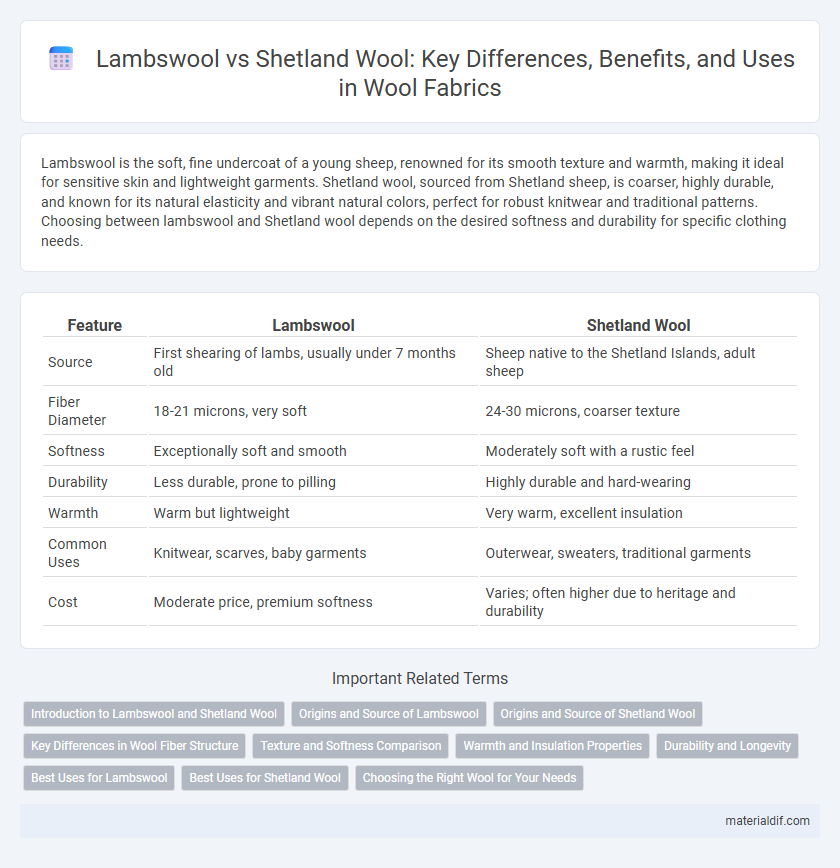Lambswool is the soft, fine undercoat of a young sheep, renowned for its smooth texture and warmth, making it ideal for sensitive skin and lightweight garments. Shetland wool, sourced from Shetland sheep, is coarser, highly durable, and known for its natural elasticity and vibrant natural colors, perfect for robust knitwear and traditional patterns. Choosing between lambswool and Shetland wool depends on the desired softness and durability for specific clothing needs.
Table of Comparison
| Feature | Lambswool | Shetland Wool |
|---|---|---|
| Source | First shearing of lambs, usually under 7 months old | Sheep native to the Shetland Islands, adult sheep |
| Fiber Diameter | 18-21 microns, very soft | 24-30 microns, coarser texture |
| Softness | Exceptionally soft and smooth | Moderately soft with a rustic feel |
| Durability | Less durable, prone to pilling | Highly durable and hard-wearing |
| Warmth | Warm but lightweight | Very warm, excellent insulation |
| Common Uses | Knitwear, scarves, baby garments | Outerwear, sweaters, traditional garments |
| Cost | Moderate price, premium softness | Varies; often higher due to heritage and durability |
Introduction to Lambswool and Shetland Wool
Lambswool is the soft, fine wool harvested from a sheep's first shearing, typically when the lamb is around seven months old, known for its exceptional softness and lightweight feel ideal for sensitive skin. Shetland wool originates from Shetland sheep, characterized by a slightly coarser texture yet renowned for its warmth, durability, and natural water resistance, making it suitable for outdoor garments. Both wools are prized for their unique fiber qualities, with lambswool offering superior softness and Shetland wool valued for resilience and versatility in traditional knitwear.
Origins and Source of Lambswool
Lambswool originates from the first shearing of a young sheep, typically under seven months old, resulting in exceptionally soft and fine fibers harvested mainly from Merino and other young lamb breeds. Shetland wool comes from the Shetland sheep native to the Shetland Islands, known for its coarser, more durable texture suited for traditional knitwear. The primary distinction lies in lambswool's fine, delicate origins versus the mature, hardy fibers sourced from Shetland sheep.
Origins and Source of Shetland Wool
Shetland wool originates from the Shetland Islands, located northeast of mainland Scotland, renowned for its resilient and fine-textured fleece derived from native Shetland sheep. This wool is distinctively softer and lighter compared to lambswool, which comes from the first shearing of young sheep typically under twelve months old. The unique climate and grazing conditions of the Shetland Islands contribute to the unparalleled warmth, durability, and natural crimp of Shetland wool fibers.
Key Differences in Wool Fiber Structure
Lambswool fibers are finer and softer, typically measuring around 16-18 microns in diameter, which contributes to its smooth and gentle texture suitable for next-to-skin wear. In contrast, Shetland wool fibers are coarser, ranging from 25-35 microns, providing greater durability and warmth ideal for traditional outerwear. The scale structure of lambswool is less pronounced than Shetland wool, resulting in reduced itchiness and enhanced comfort.
Texture and Softness Comparison
Lambswool offers a finer, softer texture with fibers typically measuring 17-19 microns, making it ideal for next-to-skin garments. Shetland wool, while more robust with fiber diameters averaging 25-30 microns, provides a coarser texture and greater durability suited for outerwear. The softness of lambswool surpasses Shetland wool due to its younger fiber origin, resulting in a smoother feel and enhanced comfort.
Warmth and Insulation Properties
Lambswool, harvested from the first shearing of a young sheep, is exceptionally soft and offers superior warmth due to its fine fibers and natural crimp that trap heat efficiently. Shetland wool, sourced from Shetland sheep in Scotland, is coarser but provides excellent insulation and durability, making it ideal for cold, windy climates. While lambswool excels in softness and lightweight warmth, Shetland wool outperforms in heat retention and moisture resistance, providing robust insulation in harsher weather conditions.
Durability and Longevity
Lambswool, sourced from the first shearing of a sheep, offers exceptional softness but tends to be less durable compared to Shetland wool, which is thicker and more resilient due to its coarse texture. Shetland wool is renowned for its longevity, retaining structure and warmth through frequent wear and washing, making it ideal for long-lasting garments. In contrast, lambswool's fine fibers are more prone to pilling and wear, limiting its optimal use to delicate, short-term apparel.
Best Uses for Lambswool
Lambswool, known for its exceptional softness and fine fibers, is ideal for garments worn close to the skin such as sweaters, scarves, and baby clothing. Its lightweight yet insulating properties make it perfect for cozy winter apparel without bulk. Compared to Shetland wool, which is coarser and more durable, lambswool offers superior comfort and warmth for sensitive skin and delicate wearables.
Best Uses for Shetland Wool
Shetland wool is best used for durable knitwear such as sweaters, scarves, and hats due to its robust texture and excellent insulating properties. It excels in traditional Fair Isle patterns and outdoor garments, providing warmth and resilience in harsh weather conditions. Compared to lambswool, Shetland wool offers greater durability and is ideal for items requiring longevity and shape retention.
Choosing the Right Wool for Your Needs
Lambswool, known for its softness and lightweight texture, is ideal for sensitive skin and cozy garments like sweaters and scarves. Shetland wool, derived from Shetland sheep, is sturdier and has excellent insulation properties, making it perfect for durable outerwear and cold-weather clothing. Choosing between lambswool and Shetland wool depends on the desired softness, warmth, and garment durability required for your specific project.
Lambswool vs Shetland Wool Infographic

 materialdif.com
materialdif.com